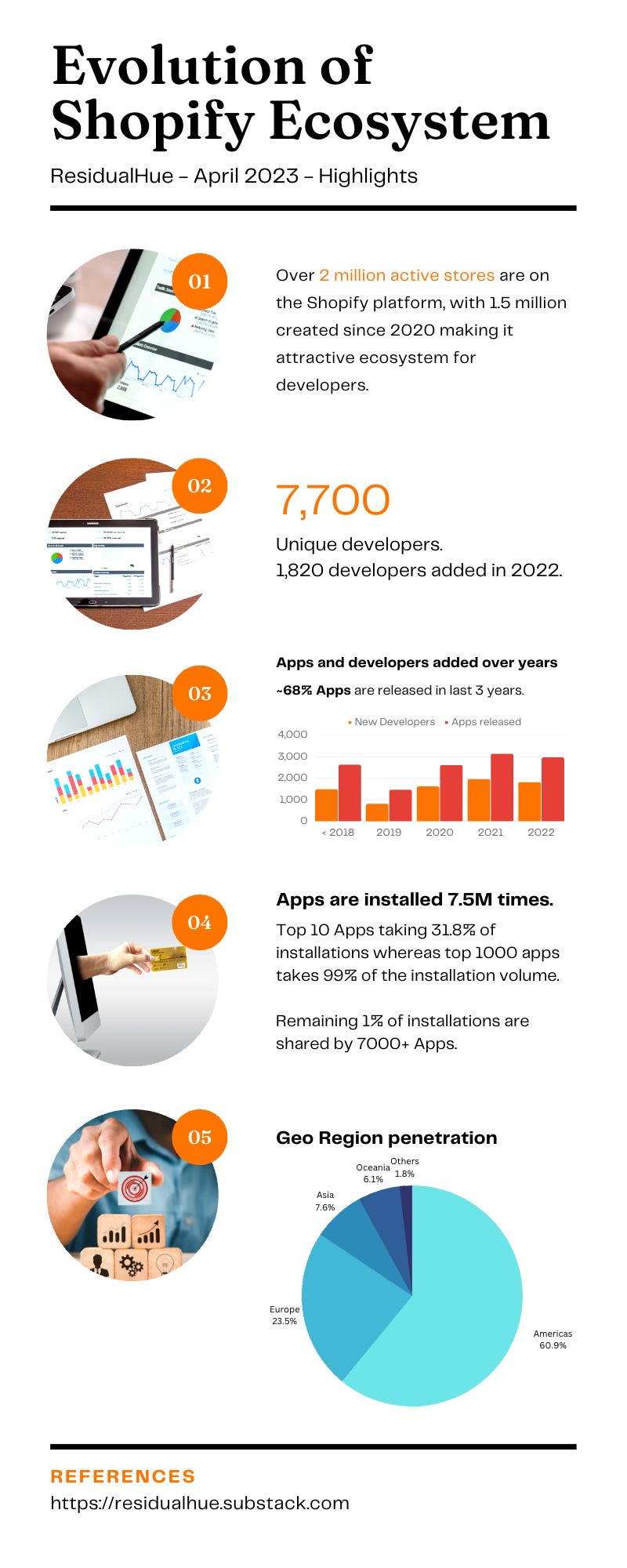Evolution of Shopify Ecosystem
Decoding the rapid growth of Shopify and its APP ecosystem, my experimentation with LLMs and more.
Shopify is a force to be reckoned with in the world of ecommerce, with over 2 million active stores on its platform. Its growth has been nothing short of impressive, with 1.5 million stores created since 2020. This trend is especially evident in North America, which boasts the largest market for Shopify, followed by Europe and Asia. The increasing number of apps available on the Shopify App Store has played a major role in enhancing the platform's capabilities and driving its popularity among online merchants allowing them to create unique identity and value for their stores.
APP Trend
The Shopify App Store offers over 12,800 apps to date, with free apps accounting for 39.6% of the total. These free apps have been installed over 7.5 million times across the platform, with the top 10 apps alone contributing to 2.39 million installations. Interestingly, 4 out of the top 5 apps are created and maintained by the Shopify team itself. As the number of new stores being created continues to rise, the number of new apps launched has slightly dipped in recent years. However, with over 500,000 new stores created in 2022 alone, there is still plenty of demand for the apps that are already available.
Over 7.5 million app installations have been made on Shopify stores to date, with the top 10 apps accounting for 31.8% of these installations. In fact, the top 1000 apps cover almost the entirety of app installations on the platform, representing 99% of the total volume. This leaves the remaining 1% of installations to be shared by a staggering 7000+ apps.
On the Shopify App Store, there are a staggering 906,000 reviews from users of various apps. Out of all the apps, Privy has received the most reviews with over 25,000 ratings and an average rating of 4.6 stars. However, when it comes to the highest-rated apps, Judge.me and Dsers take the crown with a perfect rating of 5 stars and over 14,000 stores rating them highly. These apps have clearly won over their users with their exceptional performance and usefulness.
Developer Trend
The Shopify ecosystem has also attracted the attention of developers, with over 7,700 unique developers currently contributing to the platform. On average, each developer has created 1.66 apps, with Shopify's own apps accounting for 50 apps and 1.38 million installations. The number of developers in the ecosystem has steadily increased over the years, with 2,300 developers in 2019 and a surge of 1,619 new developers in 2020. The trend continued in 2021, with 1,960 new developers joining the platform. Although there was a slight dip in 2022, with 1,820 new developers entering the Shopify ecosystem, the overall growth in developer interest is still going strong.
Overall, Shopify's growth and success can be attributed to its thriving app ecosystem and the increasing number of merchants and developers joining the platform. As the ecommerce industry continues to evolve and expand, Shopify is well-positioned to remain a key player in the space.
Data Source:
I developed a web crawler to extract public data from the Shopify App Store, and also integrated storeleads data to further enrich the dataset. While there are additional intriguing findings at the app level, those will have to be explored another time.
Other Interesting Reads
Over the past couple of weeks, I have been delving into the exciting concepts of pinecone.io and LangChain for a project. It's worth noting that both have recently secured funding. In my opinion, the layers above LLMs will be the future.
For those who haven't already, I highly recommend tuning in to the First Principles podcast by The Ken. I recently listened to Kunal Shah's episode and was fascinated by the insights and macro factors discussed.
During my exploration, I came across an intriguing concept called the Theory of Constraints.
PS: Thanks to ChatGPT for helping me reorganise my thoughts.


